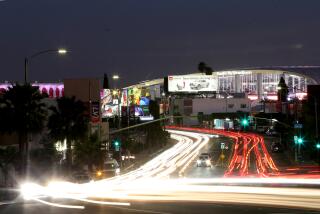Downtown Glendale post office is a powerful symbol of grace and stability.
The downtown Glendale post office rates about as much praise as any of Glendale’s public buildings in “A Guide to Architecture in Los Angeles,” the book by Robert Winter, an irreverent Occidental College architecture historian.
Winter, and co-author Robert Gebhard, describe the 1934 building tersely as “Italian Renaissance with good interior.”
That distinguishes it clearly enough from the city’s postwar monuments, such as the Central Library, which the authors call “International style touched with New Brutalism,” and the Municipal Services Building next to City Hall, cited for its “toned-down Brutalism.”
When viewed in the context of the grander public architecture of its era in Washington, New York or even downtown Los Angeles, the Glendale post office may not stand as an important monument.
Still, in its own milieu on Broadway--just east of the hammered debris of redevelopment--it is a powerful symbol of grace and stability.
It’s not a bad spot for a lunchtime stroll, either.
Everything inside imparts a feeling of integrity. Its doors are heavy brass, its floors and walls are real marble. Its high ceiling is molded into Renaissance-style squares and embossed with lively floral patterns.
The arched windows of its long hallway allow just enough light to suggest a reverent whisper as the proper tone of voice. Heavy ornamental metal casements, also richly embossed, on the wall opposite the windows so impressively define the inner sanctum of the postal staff that one would hesitate to enter without an invitation.
And yet, the solitary wooden door at the end of the east wing is open to all. It’s the one marked “Executive Office/Information.” Inside is an anteroom of gray marble walls, furnished tightly with two desks, leaving only a small passage between them.
The woman sitting on the right is pleasant and will invite you into the museum to wait for the person you wish to see. It is the waiting that makes the trip worthwhile.
The museum is a modest one of possibly 100 items that can be perused in half an hour. They include a series of old post boxes, all of substantial alloy stock; the wooden general delivery sorting box of the La Canada post office, built in 1888; several postal scales of diverse size and vintage, and a ledger book showing receipts of $14,155.31 for Dec. 11, 1925.
Most of the displays were things once relegated to storage as the area’s five original post offices were gradually replaced by Glendale substations. Later they were rescued by David Urquidez, superintendent for support services. He became unofficial curator of the museum a couple of years ago, simply by proposing it. He saw it as a way to make old things useful.
“When they come in for house cleaning, instead of throwing things away, they throw them our way,” Urquidez said.
If summoned by the woman in the anteroom, Urquidez will emerge from his spacious office just around the corner and give a tour, mixing bits of his own history with that of the post office.
“I’m a descendant of the founding family, four or five greats back,” he confided Tuesday.
Rafaela Urquidez, his grandmother several generations removed, was the daughter of Maria Verdugo, one of the last direct descendants of Spanish land grant owner Don Jose Verdugo, he said.
Some the displays are new. Urquidez pointed out a replica of a railway train, handmade by postal employee Peter DeBeers, and the painted replica of a Remington, painted on the wall by Anne Marie Urquidez, his daughter, who was 15 at the time.
But the best are intimate strokes of what Urquidez humbly identified as “cocktail trivia.” One case contains a poignant correspondence from J. F. Lilly of Valley Mortgage & Finance Co. to Will Rogers.
Lilly, assigned by the program committee to invite the famous entertainer to the ground-breaking ceremony, poured out a suitably folksy tone, asking Rogers to “run over . . . and give us the low-down on the pork barrel.”
“I notice our favorite candidate tried to put over a new flock of post-offices, but as too many of them were in Texas, and not enough in California, he was called down.”
Lilly could put on that smugness because Glendale was getting its post through more than the pork barrel.
According to another letter in the file, the property owners of the area pitched in $25,000 of its $455,000 cost, believing that “the erection of this splendid building . . . will bring much extra traffic (much of it foot traffic) along Broadway for all the years to come,” thereby increasing property values “on both sides for several blocks.”
That prediction may be tarnishing. Today, the welfare office probably brings more foot traffic along Broadway. But the old post office still stands as a gift of enduring value from the pre-brutal age. It was built, by the way, without Will Rogers’ blessing.
A curt reply from Rogers’ secretary said the actor was about to start a movie “and I doubt very much if it would be possible for him to attend.”
More to Read
Sign up for Essential California
The most important California stories and recommendations in your inbox every morning.
You may occasionally receive promotional content from the Los Angeles Times.











